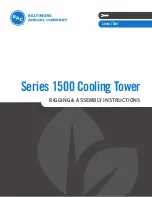
PA4S, PA5S: Installation Instructions
Manufacturer reserves the right to change, at any time, specifications and designs without notice and without obligations.
9
Check Charge
Factory charge amount and desired subcooling are shown on unit rating
plate. Charging method is shown on information plate inside unit.
For TXV, use subcooling method. For piston, use superheat method.To
properly check or adjust charge, conditions must be favorable for
subcooling charging. Favorable conditions exist when the outdoor
temperature is between 70°F and 100°F (21°C and 38°C), and the indoor
temperature is between 70°F and 80°F (21°C and 27°C). Follow the
procedure below:
Unit is factory charged for 15ft (4.57 m) of lineset. Adjust charge by
adding or removing 0.6 oz/ft of 3/8 liquid line above or below 15 ft. (4.6
m) respectively.
Allow system to operate at least 15 minutes. If conditions are favorable,
check system charge by super heat method for fixed metering device and
subcooling method for TXV. If any adjustment is necessary, adjust
charge slowly and allow system to operate for 15 minutes to stabilize
before declaring a properly charged system.
If the indoor temperature is above 80°F (27°C), and the outdoor
temperature is in the favorable range, adjust system charge by weight
based on line length and allow the indoor temperature to drop to 80°F
(27°C) before attempting to check system charge by subcooling method
as described above.
If the indoor temperature is below 70°F (21°C), or the outdoor
temperature is not in the favorable range, adjust charge for line set length
above or below 15 ft. (4.6 m) only. Charge level should then be
appropriate for the system to achieve rated capacity. The charge level
could then be checked at another time when the both indoor and outdoor
temperatures are in a more favorable range.
NOTE:
If line length is beyond 80 ft (24 m) or greater than 35 ft (11 m)
vertical separation, See Residential Piping and Long Line Guideline for
special charging requirements.
Table 6 – Accessory Usage
WARNING
!
PERSONAL INJURY AND/OR PROPERTY DAMAGE
HAZARD
Failure to follow this warning could result in personal injury and/or
property damage.
For continued performance, reliability, and safety, the only approved
accessories and replacement parts are those specified by the equipment
manufacturer. The use of non-manufacturer approved parts and
accessories could invalidate the equipment limited warranty and result
in fire risk, equipment malfunction, and failure.
Please review manufacturer's instructions and replacement part catalogs
available from your equipment supplier.
ACCESSORY
REQUIRED FOR
LOW-AMBIENT COOLING
APPLICATIONS
(Below 55°F/12.8°C)
REQUIRED FOR LONG
LINE APPLICATIONS
*
*.For tubing set lengths between 80 and 200 ft. (24 and 61 m) horizontal or 35 ft. (10.7 m) vertical differential (total equivalent length), refer to the Residential Split-System Long Line
Application Guideline.
REQUIRED FOR
SEA COAST
APPLICATIONS
(Within 2 miles/3.22 km)
Ball Bearing Fan Motor
Standard
Standard
Standard
Compressor Start Assist Capacitor and Relay
Yes
Yes
No
Crankcase Heater
Yes
Yes
No
Evaporator Freeze Thermostat
Yes
No
No
Hard Shut-Off TXV
Yes
Yes
No
Liquid Line Solenoid Valve
No
See Long Line Guideline
No
MotorMaster®
Control or
Low-ambient Pressure Switch
Yes
†
†.In units equipped with ECM OD motor, motor and fan needs to be replaced per unit accessory guide to work properly. Unit will not meet AHRI rated efficiency once motor and fan are
replaced to use this accessory.
No
No
Support Feet
Recommended
No
Recommended
Winter Start Control
Yes
‡
‡.Required if Low Pressure Switch is factory or field installed.
No
No




























